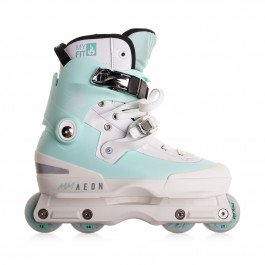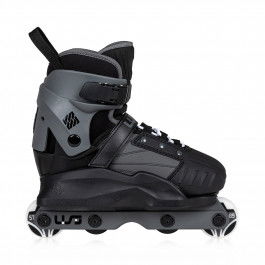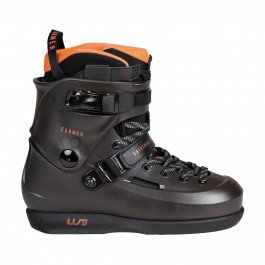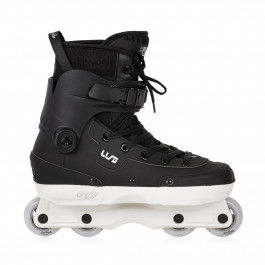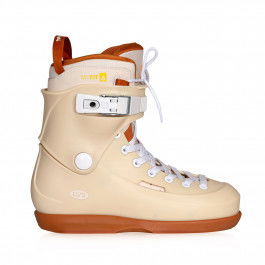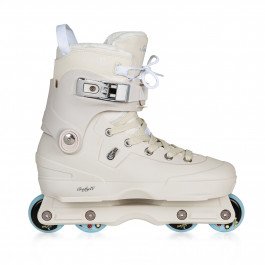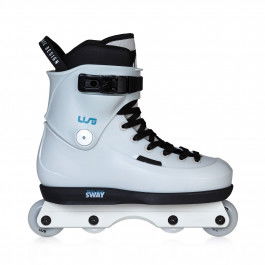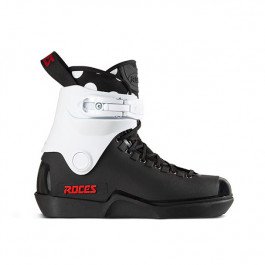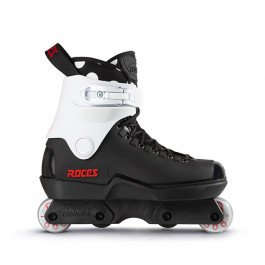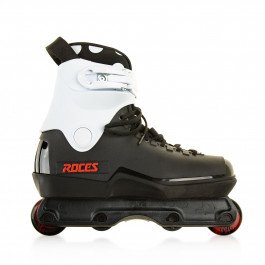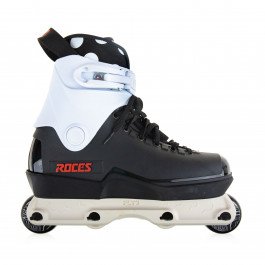Aggressive ain't that scary.
If you have ended up here in search of guidance about choosing your very first pair of aggressive skates, most likely you know something about this sport. Your knowledge may be spotty, you may have some questions — so it would be good to start with the basics, wouldn’t it? Of course, if you’ve already watched multiple edits, did your research on forums etc. and look for a straight recommendation — feel free to skip this section and go directly to skates description.
Aggressive inline skating, sometimes called extreme inline skating or by using words starting with “r” or “b” (we are still not sure if we are allowed to use them — long story!), is about using the urban landscape or places like skateparks and skate plazas to perform various stunts: tricks, spins or jumps using your inline skates. If we were to ask aggressive skaters themselves, what is the biggest appeal of this skating style for them, most would agree with the following: aggressive inline skating is first and foremost about freedom of expressing yourself and breaking your own limitations.
There is no trainer, no teamwork or predetermined rules — you have an idea for your own trick in your head and strive to master it / perform it. The freedom of approach to aggressive skating and working on your own style are great advantages of this sport. Therefore, more and more people, bored with just rolling around, are giving aggressive a shot.
Aggressive skates are specialized equipment with a number of features that distinguish them quite significantly from the “ordinary” skates. The main difference is the boot itself — usually much harder, stronger than what you’d find in other skates and with full ankle stabilization. The cuffs are lower, allowing full range of motions while protecting the ankle. They are often equipped with a deep V-cut to increase flexibility. In many cases, aggressive skates will also be slightly heavier — this is due to additional elements / parts that allow you to perform tricks. A rather big flat surface is located underneath the boot; it’s called soulplate* and allows grinding obstacles — in other words, sliding on rails and ledges.
*It’s a wordplay: soul instead of sole (in the sport’s infancy the term soleplate was also used).
Go low.
The big advantage of aggressive skates it lowered centre of gravity. Frames and wheels in a typical aggressive skate will be much lower and smaller, making it easier to control skates, perform tricks or landing jumps. The frames themselves have a reversed U indent between second and third wheel (in skates with four wheels, of course) — it’s called groove or, sometimes, a H-block and just like souplates, serves for grinding obstacles. There are also “freestyle” frames (don’t mistake the term with freestyle slalom frames!) which take only two wheels and the whole surface between them is used for grinding.
As an aggressive skater you are going to jump a lot, even if only to get on a ledge and then land after the trick. Therefore, most skates come with a shock absorber located under the heel. It’s made from material that absorbs kinetic energy, making landings easier on your heels and joints.
To sum up, a skater who switches from fitness skates to aggressive ones will feel a significant difference — aggressive skates will be slower, heavier, but much more stable. Whereas other skating styles are mostly about rolling on wheels, aggressive is more about tricks and jumps — sensation of rolling takes a back seat. You cannot even use the same skating technique as in case of other types of skates — wide souplate, located close to the ground, will scratch it if you’ll lean too much when turning and that may result in fall. Thus, the legwork on aggressive skates is more intense and you need to work more with crossovers when taking corners. Good news is in aggressive skates you are only a bit farther from the ground than in a pair of your favourite shoes, so making manoeuvres comes pretty easy!
First aggressive skates - our recommendations.
Choosing your first aggressive skates can seem quite difficult. There are many brands and models available, and the number of customization options complicates matters even further. This is why we have hand-picked three, currently available, models that will serve as a perfect introduction into aggressive inline skating.
Don’t get us wrong — we are well aware that there are many other skates worth recommendation. However, the choice was made based on qualities like: availability, ease of maintenance (including parts availability), reliability, if they are ready to roll out of the box and if stock setup is good for beginners. This is why skates available as boot only as well as those coming with freestyle or purely antirocker frames, making flat setup (4 wheels down) impossible or impractical, have not made the cut.
USD Sway
For starters, we’ll take a look at the youngest skate out of the three. Sways are available for a number of years now, but only quite recently they’ve been given a complete shell overhaul. It’s solid, spacious and coupled with thick liner gives universal fit and comfort for every type of foot. Raised heel enforces correct stance while skating.
Sways are pretty rigid for aggressive skates — a characteristic that will make life of beginners a bit easier when learning jumps. The good, old-fashioned lacing system works perfectly and plastic buckle on top of the cuff provides optimal support for the ankle. A huge soulplate makes first attempts at grinding significantly easier.
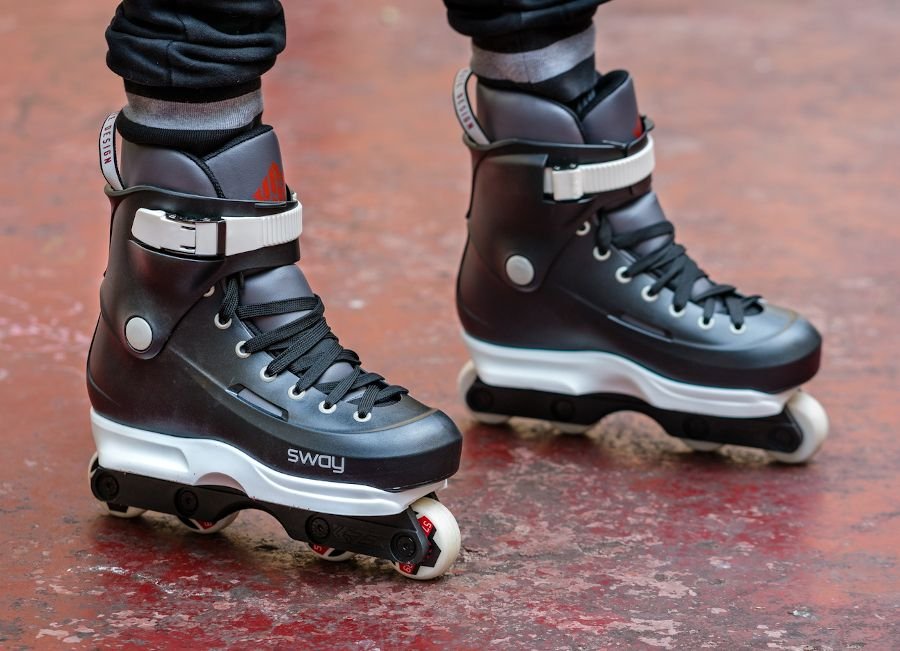
The big advantage of this model is the easiness of replacing worn parts as well as their good availability. USD Sway skates come with a proven Kizer Fluid frame, a favourite for thousands of skaters, with FLAT setup (4 wheels of the same size in one frame, all touching the ground). Thanks to 4 wheels the skates are much more manoeuvrable and the riding experience itself more dynamic. Don’t forget that, especially for people with very little or none prior skating experience, learning how to roll, turn and control the skates comes first before any trick. Starting on flat setup makes learning how to skate much easier.
A nice touch is that the skate has been given a look resembling, now out of production but nonetheless legendary in status, USD Classic Throne skates. The shape of the shell is similar to that model, retaining its key advantage — ergonomics. At the same time, by introducing a one-piece soulplate — the Sway model “fixed” all the errors of its predecessor. By recalling what made classic aggressive skates so great in the first place, Sways are not your typical low budget model — they have qualities making them a skate of choice for aggressive inline veterans and even some Pro status skaters. Not much else to say, now — these are superb skates and come highly recommended, especially for people with wider feet and high instep.
USD Aeon
Another skate coming from USD brand, the innovative project based on the unibody construction — where the frame, soulplates and the shell itself are one, inseparable element. The big advantage of this type of boot is its minimal weight — USD Aeon skates are one of the lightest ones for aggressive skating on the market, making the transition from your old “fitness” skates without having to get used to (usually) heavier aggressive boots. Unibody construction also reduces a good deal of hardware used to keep the skate parts together — gone are screws, washers etc. used to attach the frame and soulplate to the shell, making maintenance that much easier. Due to rigid, one-piece structure of the skate, the energy transfer as well as responsiveness of Aeons are unmatched in category of hardboot aggressive skates.
Aeon boot have heel position a bit flatter compared to other two models described in here (still not entirely flat due to shock absorber). For advanced skates, it’s merely a matter of preference — some like boots with significantly raised heel, other ones where it sits almost completely flat. There’s no denying, though, that raised heel enforces more “aggressive” stance, making skater leaning forward and bending knees slightly. As this effect is less effective in Aeons, beginners must keep in mind that skates are not sneakers and that they should put a bit more effort to maintain proper skating stance.
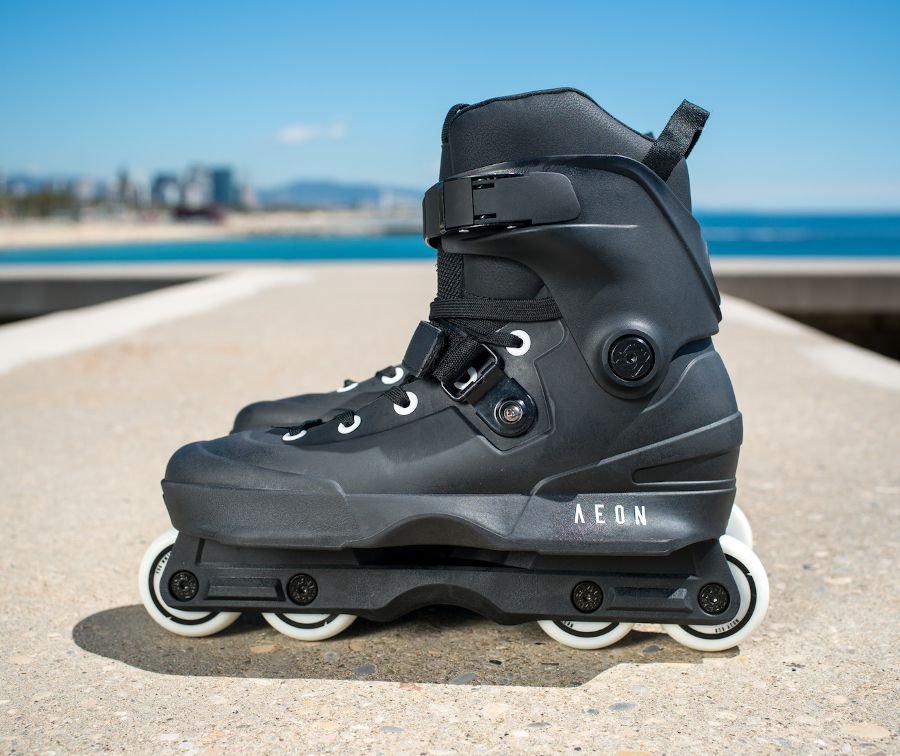
The key characteristic of Aeon, which makes them incredibly popular among aggressive skaters, is the fact that they are offering a perfect flat setup (four wheels in a skate touching ground) right out of the box. Furthermore, because the frame doesn’t have to be built around UFS mounting limitations (position of mounting screws), the first and second wheel as well as third and fourth can be placed closer to one another without sacrificing low height. Thanks to it, Aeon’s frame groove is very generous in width, making it possible even for amateurs to perform grinds easily, developing the correct style and avoiding any mistakes that can occur when learning tricks on two wheeled frames.
USD Aeon comes in three wheel size variants: 60mm, 72mm and 80mm. Aeon 60 is the “core” aggressive skate we recommend for beginners, with other two skates being made for experienced people who don’t mind increased height and want to blend aggressive and freeskating styles. It’s worth to note that Aeons are available in small shell size, perfect for adults with small feet and children: EU36-EU38. The boot itself is halfway between wide and slim fit, however, due to shell being a bit more open on the upper than most of other skates, the skate is also a good choice for people with high instep.
Last thing to cover is parts availability — when soulplates and frames are worn down, you cannot replace them separately. Instead, USD is selling a whole shell (without cuff, liner, hardware and wheels etc.), which is a fair deal considering that it costs about the same as pair of separate soulplates and frames for other skates, with added bonus of getting a fresh outer boot.
Roces M12 Lo
The flagship model of Roces brand, a skate that can be called a living fossil of sorts. Majestic 12 skates were one of the very first skates created for aggressive inline and remains hugely popular to this day. Of course, the skate has been changed significantly over decades, to stay relevant with ever evolving sport and skaters’ creativity. One key element has remained the same - unique shape of the shell, ensuring maximum comfort and great fit. It can be said that M12 is one of the pillars of aggressive skating and it will stay with the skaters for long time to come.
When creating the M12 boot, Roces used their years’ worth of expertise in making ice skates, giving it similarly raised heel. This helps skater in maintaining a correct stance and landing jumps. The shell itself is on more flexible end of the spectrum when it comes to aggressive skates, making grinds easier to perform. These days, most of the editions of M12 Lo come with antirocker wheel setup — replacing middle wheels with smaller, hard ones, which allows for easier grinding on ledges.
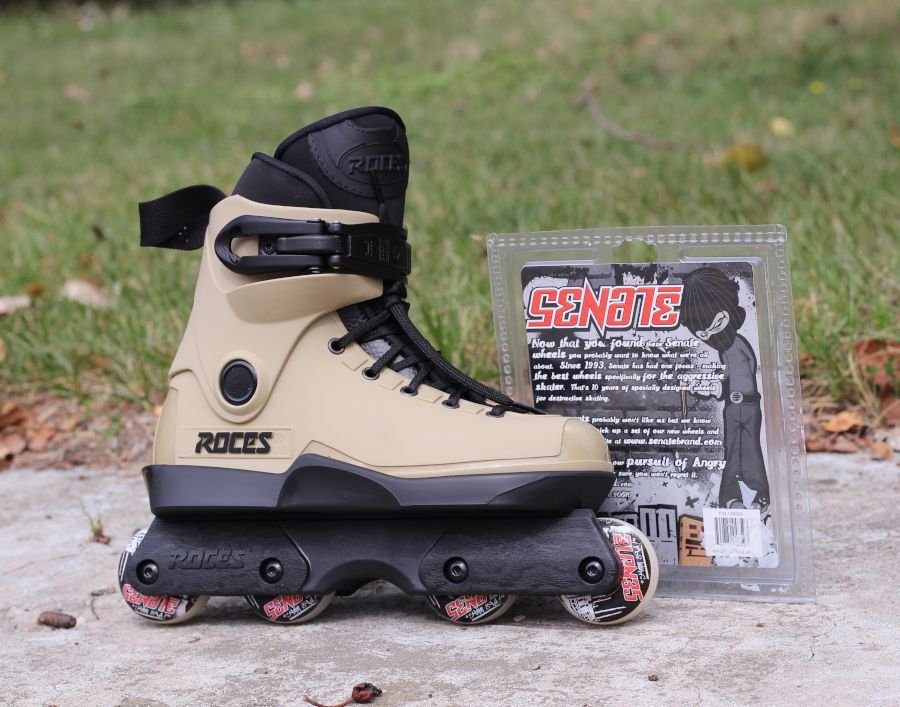
It’s a double-edged sword of sorts, with rolling around being less smooth and turning being harder. To put it simply, having only two wheels per skate touching the ground does make just skating around less enjoyable. This kind of setup allows for easier, safer grinding and even doing these tricks on obstacles that are nearly off-limits with typical flat setup to all but the best skaters out there — thick rails, rounded ledges etc. For absolute beginners, we recommend a purchase of additional four wheels of the same diameter as outer wheels in the skate and replacing middle antirockers with them. The fact that frame used in Roces M12 Lo is basically a rebranded version of highly regarded Valo frame, which was always considered as a good choice for skating flat. People who have enough of experience with skating overall, should manage just fine on antirocker setup, though — simply be prepared to adjust your technique to a different wheel setup.
M12 skates are renown for their durability — long-lasting and hard soulplate as well as nigh indestructible memory buckle (once you’ve set the length of the strap, there’s no need to adjust it every time you put on skates!) are definite highlights. These skates go through renaissance of sort in recent years — many aggressive skaters grew tired of technical novelties like carbon boots and return to proven simplicity and reliability of M12 design. No matter how experienced you are, we are pretty sure you’ll find these qualities appealing. Just like USD Aeon, Roces M12 Lo is available in small shell size, EU36-38.
It’s worth to mention two additional things. First — M12 are regarded as relatively slim fit skates. This comes from the fact that the shell itself was designed for many types of skates, including ice skates, and the intention was to provide the closest fit possible as well as the best level of control. The second — there are two versions of this skate; more up to date M12 Lo (described) and more basic M12 UFS, which comes with older style, higher cuff and liner as well as much simpler frame, which is very basic and you can say — outdated. The rest of the parts are the same, though.
Which skates to choose?
Making a choice which model to buy, as in case of all types of skates, should be preceded by answering yourself what are your expectations and preferences. How to set the bar, though, if you have never used aggressive skates before?
If you have experience with inline skating in general, it’s worth to reflect what you’ve liked in your previous/current skates and what rubber you wrong. Have you liked the heel being in certain position? Was amount of boot stiffness okay for you or would you like the boot to be more rigid or flexible? Is overall skate weight important for you?
Even if you cannot answer the above, by going for one out of the three models listed in this article you have a guarantee of one thing: you will be starting on solid, good quality skates that won’t let you down.
Then there’s the matter of fit. Broadly speaking, the key here is as follows: USD Sway for wide, USD Aeon for medium and Roces M12 Lo for slim feet. Of course, the width of the feet may be understood differently by different people, the boots have a bit different shapes and so on — this is why it’s best to try the skates on before purchase. Still, if you don’t have a chance to do that and need some further guidance, contact us at info@bladeville.com — we’ll do our best to help you decide which skate is best for you. Information about what skates you have been using in the past and how do you consider their overall fit will come in handy!
Thanks for reading and see you rolling!





